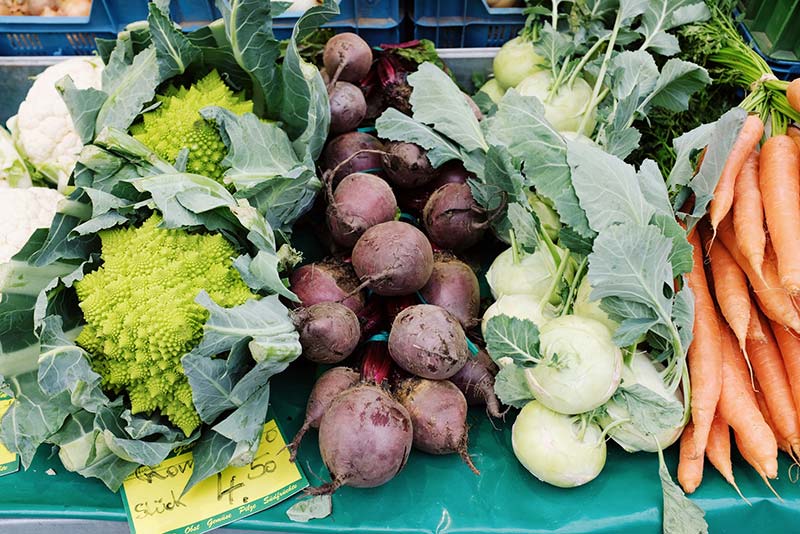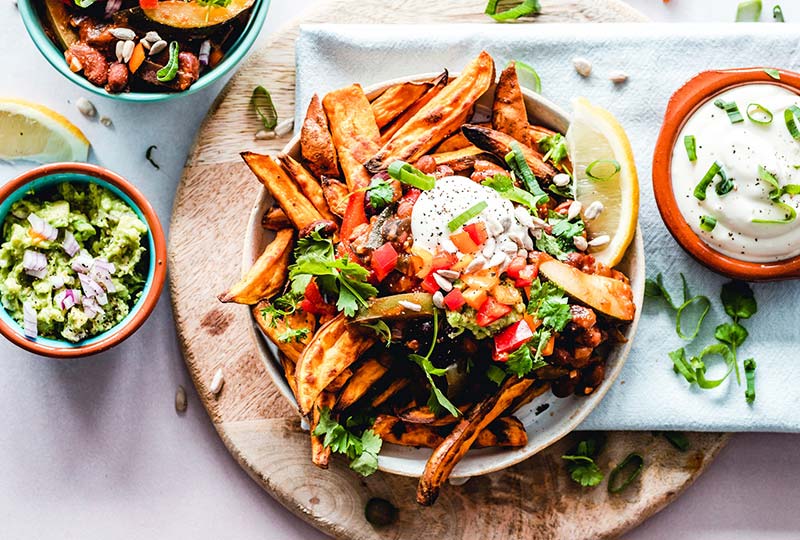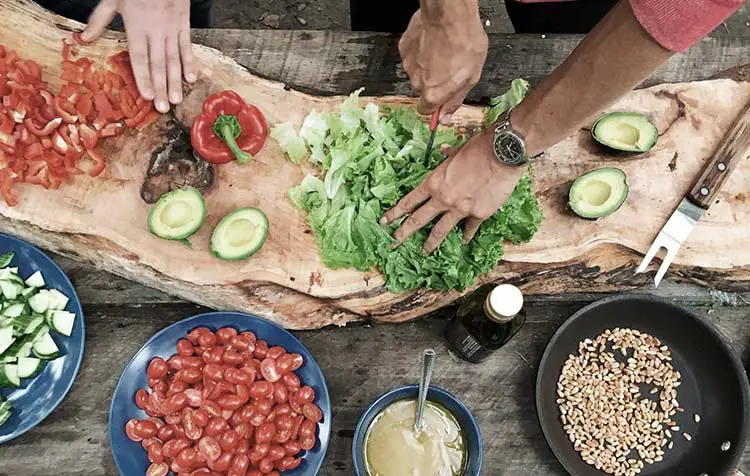How can you actually cook sustainably and eat in a climate-friendly way? And why is this so important anyway? The food sector is responsible for about 40 percent of Europe's greenhouse gas emissions - these gases are the main accelerator of the global warming.₁ Ultimately, we endanger our food security ourselves through our own eating habits. Fortunately, more and more people are changing their habits and live more sustainable consciously - this also applies to the food and meals that end up on the plate.
In this post, I want to show you how you can cook more environmentally friendly with just the simplest tips and tricks - let's go!
Notice: Even more reasons for a sustainable nutrition you will find out in the last motivating tip of this article!
15 tips for sustainable cooking
Each of us can do our part to make our diets more environmentally friendly. Therefore, use the following tips for sustainable cooking, which apply to both the Production and Purchasing of food, to which Storage and the Preparation, as well as refer to the cleaning and sanitation of the kitchen.
Notice: Maybe you already know some of the tips - great! But I think there is still something new here for everyone.
1. regional instead of global
By preferring food from your region, you avoid eternally long transport routes by ship, truck or plane. If you consciously choose food that can also grow in your environment, also automatically reduces the associated resource consumption. At the same time, you promote the businesses "around the corner" and strengthen the regional economy.
You can learn more about this in the detailed article about the regional shopping.
2. seasonal instead of year-round
Broccoli or cauliflower, for example, have their season from June to October. Outside this time is their cultivation is associated with longer transport routes or energy-intensive greenhouses. That is also why they are usually more expensive when they are not in season.
Simply use a seasonal calendar as a clear aid. Your local weekly markets are a great place to find seasonal foods with a regional background. You can learn more about seasonality in the detailed article on the seasonal shopping.
3. vegetable instead of animal
Whole books could be written about this tip for sustainable cooking. I'll try to keep it short: to produce one animal calorie, an average of seven plant calories are consumed.₂ So it would make much more sense to eat the feed we grow for factory farmed animals so we can enjoy their meat, eggs and milk. At the same time, we would be giving the Deforestation of the rainforests that have to make way for the cultivation of soy as feed and for new pastureland.
There are still so many good Reasons to eat a plant-based diet. Suitable and further articles are, for example, the following:
4. organic instead of conventional
If you want to cook sustainably, you should also consciously choose products with an organic background over conventional products. In this way you support farms with organic farmingwhich decelerates its products a little bit, but for that environmental and resource-saving produce. Thus, hardly any pesticides are used and the welfare of the animals is also a top priority. Of course, organic foods are not above reproach, but they convince with naturalness, lower pollutant loads and a significantly better taste. You can easily identify them by the organic seal.
5. fresh instead of processed

The more unprocessed, the more sustainable. Therefore, get your food as fresh and whole as possible. Ready meals or processed products from the supermarket already have a longer production process behind them, including CO2 pollution. In addition, they are usually packed with sugar or preservatives. The respective ingredient list is therefore a good guide - the shorter it is, the better.
6. loose, instead of packed in plastic
Everyone knows the problem with the Plastic waste in the environmentt. Our diet, with its vast quantities of packaged convenience foods and short-order to-go snacks, plays a crucial role in this.
So if you want to cook sustainably, you should already have Make a conscious effort to avoid plastic when shopping. Buy food in bulk as much as possible. With a little practice, this works pretty well in the supermarket - but it works even better at weekly markets and in unpacked stores. Just take Preserving jars, Stainless steel cans and a jute bag with you when you go shopping - then it will be so much easier for you.
Again, I have more articles for you:
- Zero Waste Lifestyle
- Plasticfree lifestyle
- Zero Waste Basic Equipment
- Getting started with the Zero Waste lifestyle
7. conscious instead of wasteful
Be aware that every food has a story. Some have traveled halfway around the world, others have consumed vast amounts of clean water before they reach your plate. Food waste is a massive problem of our "throwaway society". Every year, 356 million kilograms of meat are thrown away in Germany alone. 45 million chickens, 4 million pigs and 200,000 cattle therefore die in vain.₃
To reduce this waste, you should simply shop according to a plan, for example. Write down what you want to eat in the coming week. And shop strictly according to your shopping list and avoid spontaneous purchases. Just have a look at the article about the Reduce food waste. There you will find a cornucopia of tips. Also the contribution Making food last longer will help you.
Tip: Did you know that you too can save food, enjoy it for free and give it to friends? With the concept of the FoodSharings this works very simply.
8. store food in an energy efficient way
It's not just the food itself - but also the energy associated with it in your household that you should value as part of sustainable cooking. The basis of storage of your achievements from the supermarket usually represents your Refrigerator dar. Make sure that it is not placed in the sun or near a heater, otherwise it will eat up a lot of energy. In the best case scenario, it's as big as it needs to be for your household - because the fuller it is, the lower the energy consumption.
By then also sorting the food correctly into the respective refrigerator compartmentyou'll be even more environmentally friendly. After all, they will last a few days longer and will not end up in the trash can at all, or at least only in reduced numbers. Here is a brief overview₄ of the compartments:
- Refrigerator door (about 10° C): Ideal for butter, sauces, milk or drinks.
- Top shelf (about 8° C): Ideal for jam, hard cheese or cucumbers.
- Medium compartment (about 5° C): Ideal for cottage cheese, yogurt or cheese.
- Lower compartment (about 2° C): Ideal for perishables, such as meat or fish.
- Vegetable compartment (about 10 - 12 ° C): Ideal for strawberries, spinach, broccoli or leaf salads.
9. save electricity during preparation
Of course, the processing of fresh food also costs some energy, at the latest during preparation in the kitchen, because not everything can be enjoyed raw. When you make a lasagna in the oven, for example, you can use the Use residual heat and simply turn it off 2-3 minutes before you take out your food. This works very similarly for the stove. And by letting leftovers from hot meals cool down before you put them in the fridge, you help the fridge not to consume too much energy.
In the article about the Saving energy in the home you can pick up lots more tips for sustainable cooking.
10. save water when cooking
Water you can drink with your meals directly, as well as indirectly save. Directly, for example, by washing food in a bowl of water rather than under the running tap. Indirectly, by eating only or more of the foods that are not the most water-intensive. Here is a brief overview of some extremely water-intensive foods:
- Cocoa
- Roasted coffee
- Beef
- Butter
- Cheese
- Avocados
11. use environmentally friendly kitchen utensils
The wooden spoon you use should be made of durable and quickly renewable raw materials, such as bamboo wood. By investing a little more money in sturdy kitchen utensils, you can conserve natural resources and save on constant new purchases. So when a kitchen utensil breaks, take the opportunity to replace it with a sustainable alternative.
Tip: Many kitchen appliances these days are powered by batteries or electricity for convenience. But do you really need an electric citrus juicer? If you have two healthy hands, you can rely here on manual Juice presses from wood change
12. leftover recycling
If you want to cook sustainably, you shouldn't lose track of the Lose food in your "warehouse" that is about to expire. Otherwise, a lot of unnecessary stuff ends up in the garbage can and ruins the whole production effort. By buying only what you really need, you lay the foundation for keeping as few superfluous items as possible in the refrigerator. But by "cooking" even the last leftovers you round off your conscious cooking behavior. A lot can still be made into salads or soups - and your neighbors will be happy if you bring them some food.
13. proper disposal
Even if you consciously avoid waste, it cannot always be completely avoided. Therefore, make sure that you, even after cooking, your Separate waste correctly. In order to make the best possible use of organic waste, we also use a Worm box. Earthworms decompose it in a few weeks to fertile soil, with which you can grow plants on the balcony or in the garden, for example.
Tip: Did you know that some foods can be easily propagated on the windowsill? Ginger for example! In the article Multiply food, you will learn more.
14. environmentally friendly cleaning and cleaning
Now you've cooked sustainably and enjoyed your meal - but the kitchen still looks like a battlefield. Even there, you can make your cooking eco-friendly. For example, use Sink brushes from wood with agave fibers that are completely plastic-free. Also the Dishwashing liquid you can make yourself from ivy - it works perfectly.
However, I would advise you to only wash by hand if you only need to clean a few items. You should definitely wash larger quantities in the dishwasher - the devices are now much more water-efficient than washing by hand.
Tip: If you wash dishes by hand, please do not do so under a running faucet. Instead, fill a bowl with water and wash plates, cutlery, etc. in it.
15. internalize advantages
Sustainable living has so many incredible benefits that you can't just put them all into one little list. Nevertheless, I would like to give you at least the essential motivators for a climate and environmentally friendly diet:
- Guarantee food security for future generations
- Produce and consume healthy food
- Promote organic farming and small farms
- Waste less food and save money (see save money through sustainability)
- Protect environment (see Environmental protection in everyday life)
- …
Can you think of other tips for more sustainable cooking? Then always give it to me in the comments!
Sustainable and climate-friendly cooking for a permanently better world

Each of us can be both part of the Environmental problems of our time - or be a part of their solution. The decision is up to you. I think that with these tips you have enough inspiration at hand to cook even more sustainably in the future. Change is a good thing and opens the door to a new, more environmentally friendly way of eating. Make yourself aware of that.
Also feel free to use our Book "Kochen fürs Klima" for an easy start! You can get it secure here directly from the publisher.*
Do you have any questions or further tips about sustainable nutrition? Then I look forward to your comment.
Stay sustainable,

PS.: If you could use a little more motivation to go greener in the kitchen, check out these Docs about factory farming view. Because pictures say more than a thousand words. Highly recommended is the Dominion film.
References:
₁ Klima-Kollekte - Kirchlicher Kompensationsfonds gemeinnützige GmbH: Ernährung als wesentlicher Treiber des Klimawandels, available at https://klima-kollekte.de/vermeiden-reduzieren/ernaehrung. [07.05.2020].
₂ S. Weick; Brot für die Welt; Evangelisches Werk für Diakonie und Entwicklung e.V.. (2010): Meat consumption (as of March 2010). https://t1p.de/mav0. [07.05.2020].
₃ Westdeutscher Rundfunk Cologne: Tons of food in the trash? Vomit! https://t1p.de/f2tp. [07.10.2019].
₄ Deutsche Welthungerhilfe e.V.: Food properly stored, available at https://t1p.de/dlez. [07.05.2020].






Greetings Christoph! I have made the experience that a sustainable cooking at the beginning is usually also a strong taste change. With many less sustainable foods from the supermarket, we are really trained to go to the many artificial flavor enhancers. If you then slowly but surely the step into sustainable cooking was, can only be at the beginning of quite a difference. But with time it will definitely be easier. In any case, I thank you very much for your useful tips in terms of sustainable cooking. Keep up the good work and thank you!
Moin Julius! Absolutely, it's a change of taste that you have to get used to. In the end, you should just be open to new things and realize that a change doesn't happen overnight, but step by step. Today, I'm glad that the change has introduced me to so many new different, delicious meals.
Best regards
Christoph
Comments are closed.